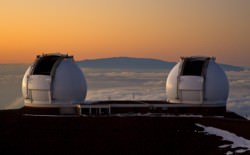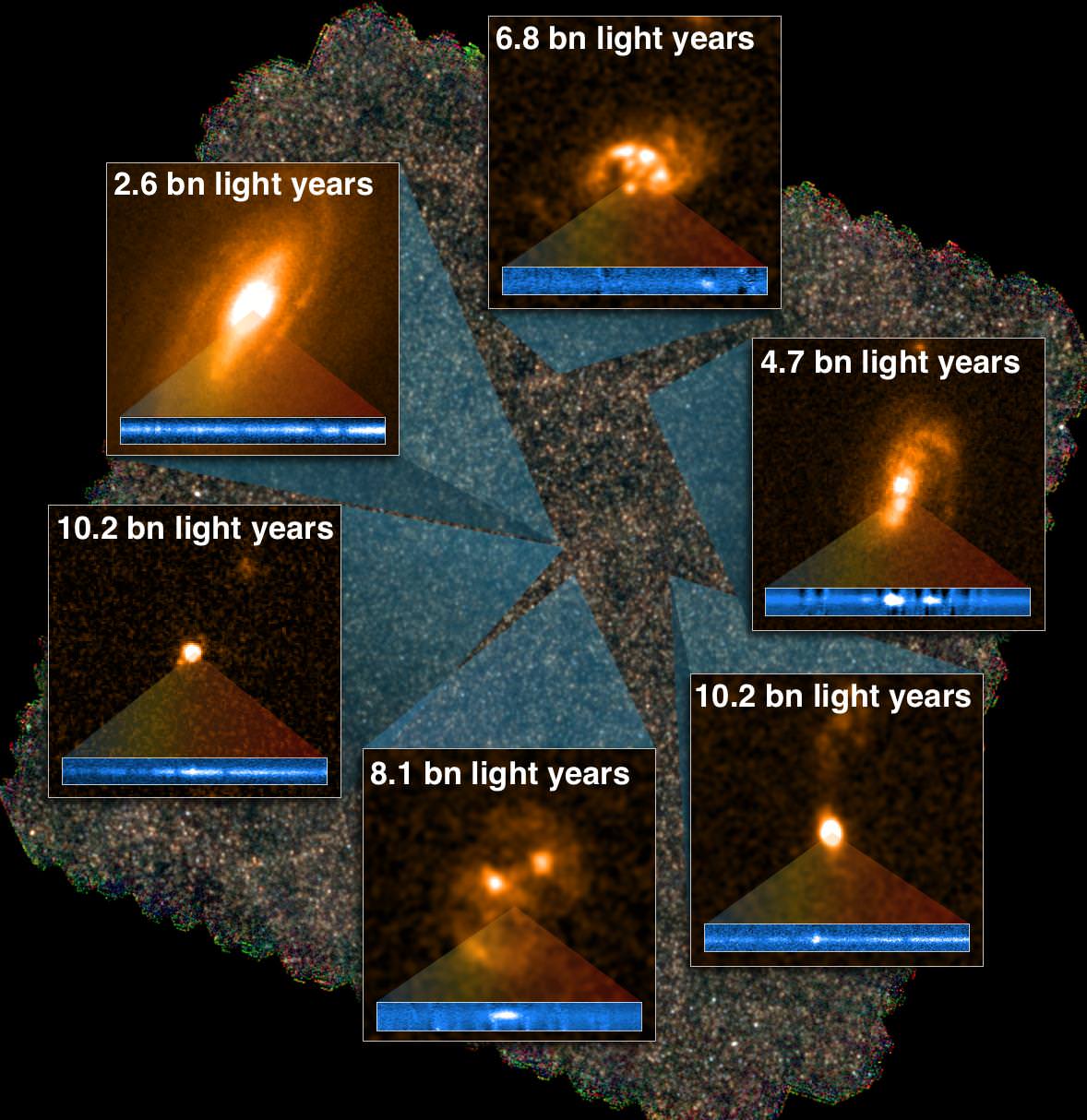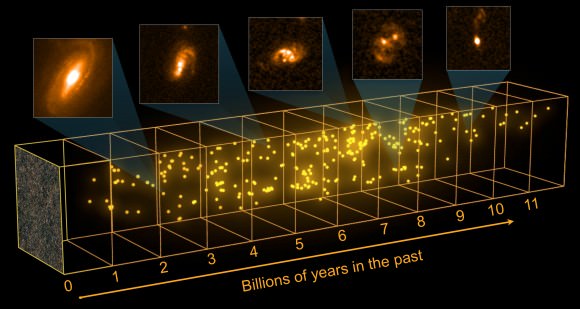Hubble images of six of the starburst galaxies first found by ESA’s Herschel Space Observatory (Keck data shown below each in blue)
Many of the brightest, most actively star-forming galaxies in the Universe were actually undetectable by Earth-based observatories, hidden from view by thick clouds of opaque dust and gas. Thanks to ESA’s Herschel space observatory, which views the Universe in infrared, an enormous amount of these “starburst” galaxies have recently been uncovered, allowing astronomers to measure their distances with the twin telescopes of Hawaii’s W.M. Keck Observatory. What they found is quite surprising: at least 767 previously unknown galaxies, many of them generating new stars at incredible rates.
 Although nearly invisible at optical wavelengths these newly-found galaxies shine brightly in far-infrared, making them visible to Herschel, which can peer through even the densest dust clouds. Once astronomers knew where the galaxies are located, they were able to target them with Hubble and, most importantly, the two 10-meter Keck telescopes — the two largest optical telescopes in the world.
Although nearly invisible at optical wavelengths these newly-found galaxies shine brightly in far-infrared, making them visible to Herschel, which can peer through even the densest dust clouds. Once astronomers knew where the galaxies are located, they were able to target them with Hubble and, most importantly, the two 10-meter Keck telescopes — the two largest optical telescopes in the world.
By gathering literally hundreds of hours of spectral data on the galaxies with the Keck telescopes, estimates of their distances could be determined as well as their temperatures and how often new stars are born within them.
“While some of the galaxies are nearby, most are very distant; we even found galaxies that are so far that their light has taken 12 billion years to travel here, so we are seeing them when the Universe was only a ninth of its current age,” said Dr. Caitlin Casey, Hubble fellow at the UH Manoa Institute for Astronomy and lead scientist on the survey. “Now that we have a pretty good idea of how important this type of galaxy is in forming huge numbers of stars in the Universe, the next step is to figure out why and how they formed.”
A representation of the distribution of nearly 300 starbursts in one 1.4 x 1.4 degree field of view.
The galaxies, many of them observed as they were during the early stages of their formation, are producing new stars at a rate of 100 to 500 a year — with a mass equivalent of several thousand Suns — hence the moniker “starburst” galaxy. By comparison the Milky Way galaxy only births one or two Sun-mass stars per year.
The reason behind this explosion of star formation in these galaxies is unknown, but it’s thought that collisions between young galaxies may be the cause.
Another possibility is that galaxies had much more gas and dust during the early Universe, allowing for much higher star formation rates than what’s seen today.
“It’s a hotly debated topic that requires details on the shape and rotation of the galaxies before it can be resolved,” said Dr. Casey.
Still, the discovery of these “hidden” galaxies is a major step forward in understanding the evolution of star formation in the Universe.
“Our study confirms the importance of starburst galaxies in the cosmic history of star formation. Models that try to reproduce the formation and evolution of galaxies will have to take these results into account.”
– Dr. Caitlin Casey, Hubble fellow at the UH Manoa Institute for Astronomy
“For the first time, we have been able to measure distances, star formation rates, and temperatures for a brand new set of 767 previously unidentified galaxies,” said Dr. Scott Chapman, a co-author on the studies. “The previous similar survey of distant infrared starbursts only covered 73 galaxies. This is a huge improvement.”
The papers detailing the results were published today online in the Astrophysical Journal.
Sources: W.M. Keck Observatory article and ESA’s news release.
Image credits: ESA–C. Carreau/C. Casey (University of Hawai’i); COSMOS field: ESA/Herschel/SPIRE/HerMES Key Programme; Hubble images: NASA, ESA. Inset image courtesy W. M. Keck Observatory.



These are great times to be an astronomer.
agree.
If it takes billions of years for the light to reach us, how can you say “the galaxies are producing 100-500 stars now.” They were producing that many stars billions of years ago and may not be producing as many or any now or just as much as the same time that frame that we observe in the time it took for a closer galaxy’s light to get here. It isn’t intelligent to talk in present tense for what something did billions and billions of years ago. Jason, it isn’t that hard to get the words right that lead to a better understanding of time when looking at the past. We can’t see what is happening now that too many journalists write as if we can. If you don’t understand the distinction, your readers won’t either…
“The galaxies, many of them observed as they were during the early stages
of their formation, are producing new stars at a rate of 100 to 500 a
year”
Gee
Robert, if it was any clearer the paragraph would be etched on a
fluorescent stone highlighted by a field of flashing neon arrows, slightly to the left a
platform would propping up a somewhat graceful, mildly obese lady sporting a
viking helmet, bellowing to the best of her ability, THIS OCCURRED IN
THE PAST.
ya moon unit
It is interesting there is this much dust at these early epochs of the universe.
LC
This is a look back into the past.
My question is if they were produced billions of years ago and the universe expanded, can we track the stars they produced and look at them now?
I cannot find any part of this article where they state the star formation is happening now, on the contrary it states quite clearly that they are observing the galaxies in the early stages of formation and in the early universe.Robert maybe you should read the the right words before you complain about them
I visited the McDonald observatory in west Texas a few months back. It is small by any of todays standards. I am 64 and had never been to an observatory before. It was stunning! I Was able to have a one-on-one with one of the resident astronomers. When the big bang occurred, (13.8 billion years ago) debrit/energy went out sphericaly in all directions. Now think about the speed of light, geometry, and where we might be sitting with in that sphere of energy that we call the universe. It was pointed out to me that what we see as the universe is only the meerist fraction of the whole picture. Light from the other side of the BANG has not and will not ever reach us.
This ought to put you to sleep in no time.
ortexgraves.com
HMMM………..Let’s see if another interpretation works as well. These are ‘starless darks’ because the galactic nucleus lost pressure holding the gas inside and this hot gas spewed outward saturating the host galaxy. This hot gas gives the appearance of star formation when it is merely visiting. As the hot gas expands it cools creating ‘dust’ aka cold gas. Result: no star formation merely a curtain call. An aged galaxy steeped in cold gas, a starless dark.
Well, they constrained it to stars:
“By gathering literally hundreds of hours of spectral data on the galaxies with the Keck telescopes, estimates of their distances could be determined as well as their temperatures and how often new stars are born within them.”
Earlier post reference to galactic aging and science support here:http://www.sciencedaily.com/releases/2012/12/121205083840.htm
Also, astronomers use the convenient reference frame of local reference frame. So they observe these events in the “now”, while the distance and a cosmological model will tell you the age of the events.
I have no words. Great!
Do you want to see the past? Let’s do some mental experiment.
The Andromeda galaxy is 2.52 million light years far from us. Thereby now we can see what was going on there exactly 2.52 million light years ago because the light from Andromeda reaches us only now. Now we can see what was happening there while we have had dinosaurs here on Earth.
Now we should change the `things` in opposite direction: Let us put the very-very powerful telescope on one of the planet in the center of Andromeda galaxy.
I should say it again this is only mental experiment and imagine we have found the way to speed up the rate of light. This means we are able to appear on Andromeda (holding in hands our best of the world telescope) quicker than light.
– Now the time to look through the telescope. We see the Earth. We can see the light from the Earth which as far from Andromeda as 2.52 million light years. The most important things in our mental experiment:
1. x+y=y+x.
2. We know the way to speed up the rate of light.
Thereby from Andromeda we can see dinosaurs walking on our planet. OMG!
Math tells us we can watch the every period of time of our planet just moving near or moving away from the earth if we can speed up the speed of light. In fact we can move away from the Earth as far as 10 billion light years and can see from there the formation of the Earth. We can also move closer and can see the battles happened in WW2 – for this we should put the telescope on the planet which as far from us as 70-73 light years just.
And yes 🙂 Special for Google Labs:
Google Earth: history edition.